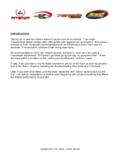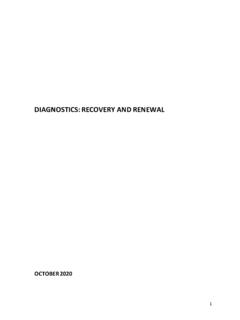Transcription of Central Venous Catheter Hub Cleaning Prior to Accessing
1 Ce n tra l Venous Catheter Hub Cleaning Prior to Accessing Centers for Disease Control and Prevention (CDC) Dialysis Bloodstream Infection (BSI) Prevention Collaborative Protocol This protocol outlines a suggested approach to Cleaning Catheter hubs Prior to Accessing the Catheter for dialysis. It is based on evidence where available and incorporates practice recommendations from collaborative members and theoretical rationale when published evidence is unavailable. Definitions Catheter refers to the Central Venous Catheter (CVC) Hub refers to the end of the CVC that connects to the blood lines or cap Cap refers to a device that screws on to and occludes the hub Limb refers to the Catheter portion that extends from the patient s body to the hub Blood lines refer to the arterial and Venous ends of the extracorporeal circuit that connect the patient s Catheter to the dialyzer Catheter Connection and Disconnection Steps: Connection Steps: 1.
2 Perform hand hygiene and don new clean gloves. 2. Clamp the Catheter (Note: Always clamp the Catheter before removing the cap. Never leave an uncapped Catheter unattended). 3. Disinfect the hub with caps removed using an appropriate antiseptic (see notes). a. (Optional) Prior to cap removal, disinfect the caps and the hub that is visible and discard the antiseptic pad ( , use a separate antiseptic pad for the subsequent disinfection of the hub). b. Remove the caps and disinfect the hub with a new antiseptic pad for each hub. Clean the sides (threads) and end of the hub thoroughly with friction, making sure to remove any residue ( , blood).
3 C. Using the same antiseptic pad, apply antiseptic with pressure to the Catheter , moving from the hub at least several centimeters towards the body. Hold the limb while allowing the antiseptic to dry. d. Use a separate antiseptic pad for each hub/ Catheter limb. Leave hubs open ( , uncapped and disconnected) for the shortest time possible. 2 4. Always handle the Catheter hubs aseptically. Once disinfected, do not allow the Catheter hubs to touch nonsterile surfaces. 5. Attach sterile syringe, unclamp the Catheter , withdraw blood, and flush per facility protocol. 6. Repeat for other limb (this might occur in parallel).
4 7. Connect the ends of the blood lines to the Catheter aseptically. Disinfecting the ends of the blood lines is not required IF the blood lines have been handled aseptically Prior to connection and care has been taken to not contaminate the blood lines. 8. Remove gloves and perform hand hygiene. Disconnection Steps: 1. Perform hand hygiene and don new clean gloves. 2. Clamp the Catheter (Always clamp the Catheter before disconnecting. Never leave an uncapped Catheter unattended). 3. Disinfect the Catheter hub before applying the new cap using an appropriate antiseptic (see notes) a. (Optional) Disinfect the connection Prior to disconnection.
5 If this is done, use a separate antiseptic swab for the subsequent disinfection of the hub. b. Disconnect the blood line from the Catheter and disinfect the hub with a new antiseptic pad. Clean the sides (threads) and end of the hub thoroughly with friction, making sure to remove any residue ( , blood). c. Use a separate antiseptic pad for each hub. Leave hubs open ( , uncapped and disconnected) for the shortest time possible. 4. Always handle the Catheter hubs aseptically. Once disinfected, do not allow the Catheter hubs to touch nonsterile surfaces. Hold the Catheter until the antiseptic has dried.
6 5. Attach the new sterile caps to the Catheter aseptically. Use caution if tape is used to secure caps to the Catheter (see notes). 6. Ensure that Catheter is still clamped. 7. Remove gloves and perform hand hygiene. Notes / Discussion Antiseptic Use and Selection As described in the 2011 CDC/Healthcare Infection Control Practices Advisory Committee (HICPAC) Guidelines for the Prevention of Intravascular Catheter -Related Infections, Prior to Accessing the Catheter hub it should be disinfected with an appropriate antiseptic (greater than chlorhexidine with alcohol, 70% alcohol, or 10% povidone-iodine).
7 There is not enough evidence to recommend one antiseptic over the others. Generally, antiseptics should be allowed to dry for maximal effect. If using 70% alcohol, sterile antiseptic pads should be used (sterile pads are labeled sterile and packaging for nonsterile pads often does not state whether the pads are sterile or nonsterile). For 3 practical reasons, pads or similar products might be preferred over other forms of antiseptics ( , swabsticks) for disinfecting the Catheter as they are malleable and allow for vigorous Cleaning of small spaces. If using an antiseptic that leaves a residue ( , chlorhexidine), avoid allowing large amounts of antiseptic to enter the lumen of the Catheter to avoid potential toxicities to the patient.
8 If using chlorhexidine, ensuring that all blood residue is removed is particularly important to maximize the effect of the antiseptic. Soaking Caps The role of soaking caps in an antiseptic Prior to removing them is not clear. It is not a CDC/HICPAC recommendation. This procedure is described in the 2000 National Kidney Foundation s Kidney Disease Outcomes Quality Initiative (KDOQI) Vascular Access Guidelines but was not included in the 2006 update. Handling Catheter hubs Catheter hubs should always be handled aseptically. Once disinfected, the Catheter hubs should not be allowed to touch nonsterile surfaces.
9 This might be best performed by holding them until the antiseptic dries. During this time, the staff member performing the procedure can also ensure that the Catheter remains clamped. When disinfecting Catheter hubs , only clean, nonsterile gloves are required if aseptic technique is maintained. Bloodline Disinfection When Accessing the line, disinfecting the ends of the blood lines is not required if care has been taken not to contaminate the ends of the blood lines ( , through careful aseptic technique). Blood lines can become contaminated during connections and disconnections, as well as during the priming process.
10 Contact with contaminated prime waste from prime buckets that have not been properly cleaned and disinfected or through backflow from waste handling ports must be avoided. Disinfecting the bloodlines does not address this issue. Disconnection and Line Reversals Catheter hubs should be disinfected again after disconnecting from bloodlines and before replacing a new cap at the end of a treatment. This should be done in a manner similar to that used when disinfecting the hub Prior to Accessing . Disinfecting the Catheter hub and the end of the extracorporeal blood line should also be performed if, during a treatment, a patient must be disconnected and their blood is re-circulated.

















